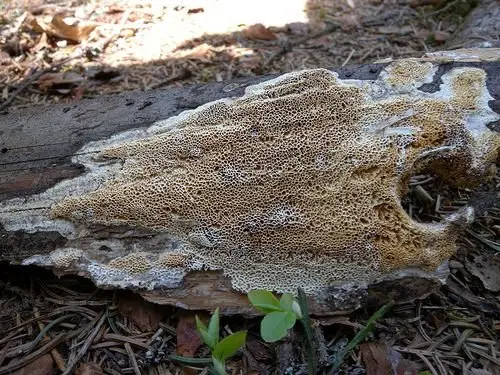White house mushroom (Amyloporia sinuosa)
- Division: Basidiomycota (Basidiomycetes)
- Subdivision: Agaricomycotina (Agaricomycetes)
- Class: Agaricomycetes (Agaricomycetes)
- Subclass: Incertae sedis (of uncertain position)
- Order: Polyporales (Polypore)
- Family: Polyporaceae (Polyporaceae)
- Genus: Amyloporia (Amyloporia)
- Type: Amyloporia sinuosa (White house mushroom)

Description:
The house mushroom is also known as Antrodia sinuosa (Antrodia sinuosa) and belongs to the genus Amyloporia of the Polypore family. It is an arboreal species that is widely known for causing brown rot on coniferous trees.
Fruiting bodies are thin annuals of white or cream color, have a prostrate shape and can reach 20 cm. Fruiting bodies are hard and thick with a thickened or, conversely, thinned edge. The spore-bearing surface is tubular, leathery or leathery-membranous, whitish-cream to light brown in color. The pores are large with jagged edges, rounded-angular or sinuous, later the walls of the pores become split, and sometimes labyrinthine. On the surface of the hymenophore, thickenings are sometimes formed in the form of tubercles, which are covered with pores. Old fruit bodies are dirty yellow, sometimes brownish.
The hyphae system is dimitic. There are no cystides. Club-shaped basidia have four spores. Spores are non-amyloid, unstained, often cylindrical. Spore sizes: 6 x 1-2 microns.
Sometimes the white house mushroom infects the parasitic species of the ascomycete fungus Calcarisporium arbuscula.
Spread:
The house mushroom is widespread in the countries of the boreal zone of the Northern Hemisphere. It is especially common in the countries of North America, Europe, North Africa, Asia, and is also known in New Zealand, where it grows on metrosideros. In other countries, it grows on coniferous, occasionally deciduous, tree species.
Related types:
The white house mushroom is easy to identify by the irregular pores of the hymenophore and by the light brown color of the dried fruiting bodies. This species is similar in appearance to such types of mushrooms as: Antrodiella rata, Ceriporiopsis aneirina, Haploporus papyraceus, Oxyporus corticola, Oxyporus latemarginatus.









